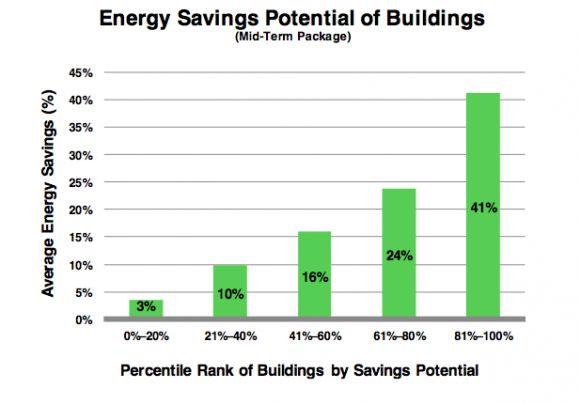Over the last few years, the handful of startups developing virtual energy auditing services have cumulatively analyzed well over a billion square feet of commercial buildings. While virtual audits -- also known as no-touch audits or rapid energy modeling -- aren't yet an industry standard, they continue to gain momentum.
By profiling a building's energy consumption using meter data, mapping tools and even pictures of the structure, virtual audits offer a faster, lower-cost way of targeting efficiency opportunities. They are not as detailed as putting an auditor on site, but they can help utilities and energy service professionals quickly find the best targets.
With so many buildings now getting the virtual auditing treatment, companies are finding some interesting trends amidst all that data.
Earlier this year, FirstFuel looked at 60 million square feet of buildings in its database and found that over half of the efficiency opportunities were simple behavior changes and tweaks in operations. If scaled up to the entire commercial building stock across the U.S., the company concluded that $17 billion in savings could theoretically be realized with no equipment retrofits at all.
Retroficiency, another up-and-comer in the space, is out with its own report today featuring some insights gained through its auditing platform. The company took a sample of 500 commercial buildings and looked at different scenarios for energy savings potential. It found five important trends.
1. High-potential buildings offer way more savings than low-potential buildings.
This seems pretty obvious. But the difference between high-potential buildings and low-potential buildings is much greater than it may appear. Retroficiency found that the top 20 percent of buildings sampled had savings potential of more than 40 percent, while the bottom 20 percent only offered 3 percent savings. This proves the importance of prioritization for utilities and organizations with large portfolios of buildings.
“Optimized targeting is a big topic of discussion amongst utilities, energy service providers, and other customers. It’s no surprise, given orders of magnitude difference between a building with high potential and one with low potential," said Retroficiency CEO Bennett Fisher.

2. Traditional metrics for measuring energy intensity aren't great tools for gauging savings.
The two most common benchmarking tools, Energy Star and Energy Use Intensity (EUI), are used to compare buildings with similar characteristics. But Retroficiency found that they're not great indicators for targeting the best immediate savings potential. For example, offices with a higher EUI are likely to have data centers attached, which may make it harder or more costly to cut energy consumption.
As the scatter plot below shows, office buildings with a lower EUI may actually be the fastest way to cut energy use. Again, this goes back to understanding which buildings in a portfolio to prioritize first.

3. End-use consumption doesn't necessarily correlate with savings potential.
Heating and cooling equipment often represents the highest proportion of energy consumption in facilities, but it doesn't always offer the best savings. For example, although lighting only makes up about 15 percent of energy use in a commercial office building, it can offer more than 30 percent of the energy savings potential because of its quick payback. As the chart below shows, the same is true in other types of facilities as well.

4. Extending a payback period can offer a lot more savings.
Building owners are always looking to pay back their efficiency investment in the shortest period possible. But Retroficiency found that increasing payback periods from short-term to mid-term in length offers an additional 3.4 percent of annual savings on average. This allows for bundling projects together, reaping more savings than a one-off measure that may be attractive only because it offers a rapid payback.

5. Saving energy and reducing carbon emissions can be two separate strategies.
There's a strong correlation between CO2 savings and energy savings, but the relationship isn't always direct. Investing in LED lighting may reduce electricity consumption in a building, but it could also force the heating system to work harder without conventional lights providing added warmth. This could actually increase carbon emissions, depending on how much the fuel mix is shifted. Before investing in retrofits, it's important to distinguish between a carbon reduction strategy and energy reduction strategy.

As virtual auditors continue to comb through America's building stock, expect insights like these to emerge.
“We have to be more comprehensive when we evaluate buildings -- both in terms of measures and how combinations of measures fit within each decision-maker’s specific goals and thresholds. Any one building may have a huge incremental savings opportunity when all of the options are considered,” said Fisher.



